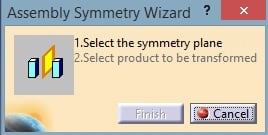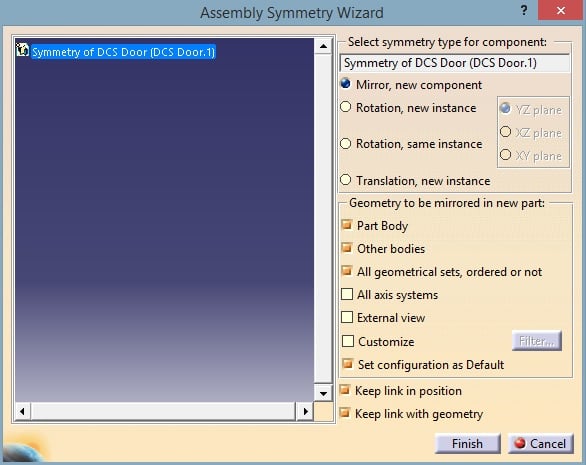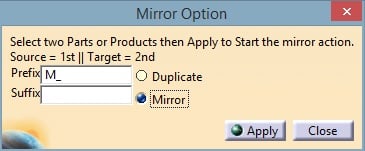
 Useful tips on quickly creating symmetrical models and duplicating data.
Useful tips on quickly creating symmetrical models and duplicating data. This Tips and Tactics will display how both Mirror and Symmetry work together to reduce modeling time and create symmetrical models.
The Symmetry function in CATIA V5 is used to create a symmetrical mate to a part or assembly. This allows users to quickly craft only half of an assembly, and then mirror the other half to create a perfectly symmetrical product.
For example: Automotive modelers use this function to create a passenger-side door from the drivers-side door, removing the need to model both. After creating the symmetrical copy, both doors may be used separately for measuring or further design of the product.
In 3DCS, a similar function known as Mirror can be used. This function allows 3DCS’s Moves, Tolerances and Measures (MTMs) as well as GD&T data to be mirrored to the opposite assembly, allowing the user to easily copy their work from one side to the other.


To use the Symmetry tool, start with the Assembly Design workbench.
 toolbar . It will begin by asking for the symmetry plane. The user can select the yz plane, a pre-created plane or a planar feature.
toolbar . It will begin by asking for the symmetry plane. The user can select the yz plane, a pre-created plane or a planar feature.NOTE: It’s important which product in the tree is active. If the user wants to create a symmetry copy of the whole assembly, then the top assembly must be active. Similarly, if one particular part is to be copied, the part’s top product needs to be active.

Once the user has a plane and part to create a symmetry copy, the user is given a few options to describe what features in the part to copy:
Symmetry type: The user can select how the part or assembly is to be created: Mirror, Rotated or Translated.
Geometry: The user will need to specify where the geometry is created in. If the part only contains surfaces, then All Geometrical Sets should be selected.
Links: When mirroring, the user can specify if the geometry is to be linked with the original geometry. If deactivated, the mirrored part(s) will be a reference to the original part.
Activate 3DCS in the drop down and update the model.
The new parts that were created in CATIA will be added to the 3DCS storage tree. However, the 3DCS MTMs (Moves, Tolerances, and Measures), points, features, and extracted GD&T (the 3DCS data) are only on the original part.
This means that the next step is to copy the 3DCS data onto the new part:

This will copy all of the 3DCS data onto the new part, leaving you with a fully copied, symmetrical part with all of the MTMs, features, points and extracted GD&T that were on the original.
Find more Tips and Tactics at DCS’s blog at http://blog.3dcs.com/topic/tt.
Sign up for DCS's newsletter (http://www.3dcs.com/mailing-list.html) to get each month's Tips and Tactics sent right to your mailbox.
Questions? Call or email DCS, and we’d be happy to help!
Dimensional Control Systems (248) 269-9777
These Stories on 3DCS
No Comments Yet
Let us know what you think